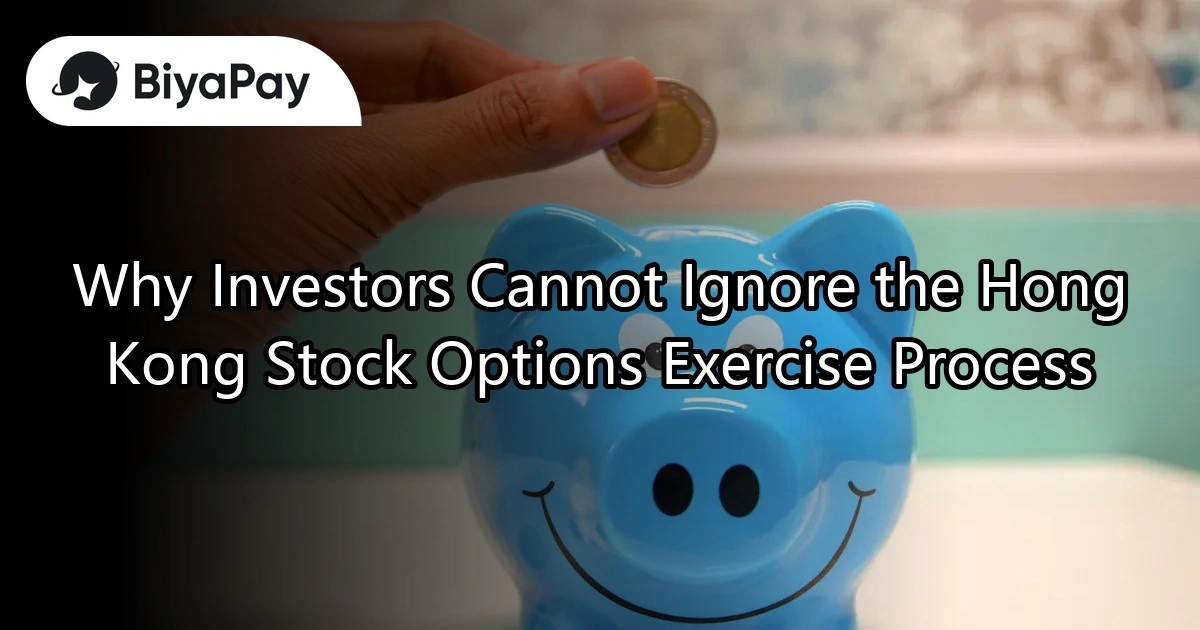- EasyCard
- Trade
- Help
- Announcement
- Academy
- SWIFT Code
- Iban Number
- Referral
- Customer Service
- Blog
- Creator
Why Investors Cannot Ignore the Hong Kong Stock Options Exercise Process

Image Source: unsplash
The Hong Kong stock options exercise process directly affects your investment outcomes. You need to understand every detail of the exercise process to avoid unnecessary losses. The exercise involves the conditions, timing, and funding preparation for executing the contract, which impact your trading results. Ignoring the exercise process may cause you to miss the best market opportunities or even lead to capital losses. Mastering the exercise process not only helps safeguard your funds but also enhances investment returns.
Main Steps of the Hong Kong Stock Options Exercise Process

Image Source: pexels
Exercise Conditions and Eligibility
Before proceeding with the Hong Kong stock options exercise process, you need to confirm whether you meet the exercise conditions and eligibility criteria. Each option contract contains specific terms that outline the conditions for exercising the option. For example, the option’s strike price must have a specific relationship with the market price to allow exercise. You should carefully read the contract terms to ensure complete understanding.
Additionally, exercise eligibility depends on your account status. You need to ensure your account has sufficient funds or holdings to support the exercise operation. Some Hong Kong banks or brokers may require additional documents or proof of funds. Therefore, confirming the relevant requirements with your broker in advance is very important.
Tip: Regularly review your option contract terms to avoid missing exercise opportunities due to overlooked details.
Time Restrictions for Exercise
In the Hong Kong stock options exercise process, time restrictions are a critical factor you must pay attention to. Most Hong Kong stock options are European-style, meaning you can only exercise them on the expiration date. You need to closely monitor the contract’s expiration date and prepare in advance.
The exercise cutoff time is typically 4:30 p.m. (Hong Kong time) on the trading day. If you fail to submit an exercise request before this time, the option will automatically expire. This could result in the loss of potential profit opportunities. Therefore, setting reminders or staying in contact with your broker ensures you don’t miss the optimal exercise timing.
Note: Ignoring exercise time restrictions may lead to significant losses, so plan ahead carefully.
Settlement Requirements and Funding Preparation
After completing the Hong Kong stock options exercise process, you need to meet settlement requirements. This includes paying the funds required for the exercise or delivering the relevant stocks. For a call option, you need to prepare sufficient funds to purchase the stocks; for a put option, you need to ensure your account has enough stocks available for delivery.
Settlement is typically completed within two business days after the exercise (T+2). You should check your account balance in advance to ensure sufficient funds. If funds are insufficient, the broker may reject your exercise request or even take additional measures against your account.
Recommendation: Use financial management tools to track your funding status and maintain communication with your broker to ensure smooth settlement.
Impact of the Exercise Process on Investors
Strategies to Enhance Profit Opportunities
The Hong Kong stock options exercise process can help you seize market profit opportunities. When you are familiar with exercise terms and execute the exercise on time, you can maximize returns. The smooth completion of the exercise process demonstrates market efficiency, and investors’ rational trading behavior proves the effectiveness of risk control measures. Deep and substantive exercises have been effectively executed, showing positive market outcomes.
You can adopt the following strategies to enhance profit opportunities:
- Plan Exercise Timing in Advance: Set reminders to avoid missing exercise deadlines.
- Regularly Review Contract Terms: Ensure full understanding of exercise conditions to avoid missing opportunities due to overlooked details.
- Maintain Communication with Your Broker: Stay informed about the latest market dynamics and exercise requirements.
Tip: Mastering the details of the exercise process can help you stay competitive in the market.
Role of Exercise in Risk Management
The exercise process not only enhances profit opportunities but also effectively manages risks. When you use option exercises rationally, you can protect your funds during market volatility. Exercising options can help you lock in prices, avoiding losses due to market fluctuations. For example, a put option can provide protection during stock price declines, while a call option can lock in costs during price increases.
Furthermore, rational trading behavior and effective risk control measures in the exercise process highlight the importance of options for investors. You can use exercises to balance risks in your portfolio and ensure funding stability.
Note: Failing to use exercises rationally may lead to capital losses, so plan carefully in advance.
Long-Term Impact on Investment Portfolios
The Hong Kong stock options exercise process has a profound impact on your long-term investment portfolio. Exercising options can help optimize asset allocation and enhance portfolio stability. Data shows that the number of option trading accounts has grown steadily, with the latest figure exceeding 1 million, reflecting market activity. The participation of individual investors slightly surpasses that of institutional investors, indicating the demand and usage of options among retail investors.
Through exercising options, you can maintain flexibility during market volatility and use options to boost returns. Rational trading and effective risk control measures in the exercise process underscore the importance of options for risk management and return enhancement in long-term portfolios.
Recommendation: Regularly review your portfolio and adjust exercise strategies based on market conditions to ensure long-term returns.
Risks of Ignoring the Hong Kong Stock Options Exercise Process
Potential Losses from Missing Exercise Timing
Ignoring exercise timing may cause you to miss potential profit opportunities. Hong Kong stock options typically have strict time restrictions, especially European-style options, which can only be exercised on the expiration date. If you fail to submit an exercise request within the designated time, the option will automatically expire. This not only means you cannot realize potential profits but also results in the complete loss of the option premium paid.
For example, suppose you hold a call option with a strike price of USD 50, and the market price rises to USD 60 on the expiration date. If you fail to exercise in time, you will miss a potential profit of USD 10 per share. For investors holding large contracts, this loss can be substantial.
Note: Set reminder functions to ensure you don’t miss exercise deadlines.
Transaction Failures Due to Insufficient Funding Preparation
Exercising options requires sufficient funds or stocks to support the transaction. If you fail to prepare the necessary funds in advance, the broker may reject your exercise request, leading to transaction failure. This not only causes you to miss profit opportunities but may also affect your credit rating or account status.
For example, suppose you plan to exercise a call option to purchase 1,000 shares of a company’s stock at a strike price of USD 40 per share. You need to prepare USD 40,000 in funds. If your account balance is insufficient, the broker may cancel your exercise request and potentially impose additional measures, such as fines or trading restrictions.
Recommendation: Regularly check your account balance and confirm funding requirements with your broker to avoid transaction failures due to insufficient funds.
Negative Impact on Investment Strategies
Ignoring the exercise process may negatively impact your overall investment strategy. Exercising options is a critical component of options trading, helping you achieve asset allocation goals. If you fail to exercise correctly, it may lead to an imbalanced portfolio, increasing risks.
For example, suppose your investment strategy involves using put options to hedge against market declines. If you fail to exercise in time, your portfolio will lack the intended protection when market prices fall. This could lead to larger capital losses and affect your long-term investment goals.
Recommendation: Regularly review your investment strategy to ensure exercise plans align with overall goals and adjust based on market changes.
Practical Case Study: Common Issues in the Hong Kong Stock Options Exercise Process

Image Source: pexels
Consequences of Not Understanding Exercise Terms
Failing to understand exercise terms can lead to significant investment losses. Many investors overlook detailed terms in the contract, such as strike price, expiration date, and settlement requirements, when purchasing options. These terms directly affect the success of the exercise. For example, some investors miss the optimal exercise timing due to not noticing the relationship between the strike price and market price, resulting in the complete loss of the option premium.
Additionally, there are other common issues in the market, such as overly strict position limits. Initially, the open position limit was 20 contracts, later adjusted to 100 or 200 contracts, but it still fails to meet the needs of some institutional investors. These restrictions limit investors’ flexibility, increasing trading challenges.
Tip: Before purchasing options, carefully read the contract terms and confirm all details with your broker to avoid losses due to misunderstandings.
Losses from Ignoring Exercise Time Restrictions
Exercise time restrictions are one of the most commonly overlooked issues in Hong Kong stock options trading. Most Hong Kong stock options are European-style, exercisable only on the expiration date. If you fail to submit an exercise request within the designated time, the option will automatically expire, rendering potential profits unattainable.
For example, an investor holding a call option with a strike price of USD 50 saw the market price rise to USD 60 on the expiration date. However, due to failing to exercise in time, they missed a potential profit of USD 10 per share. Such cases are not uncommon, especially among novice investors.
| Issue Type | Specific Context and Impact |
|---|---|
| Position Limits | Conflicts exist between investors’ demand for option positions and current restrictive limits. |
| Entry Barriers | High market entry requirements, such as USD 500,000 in funds and simulated trading experience, increase psychological pressure. |
| Account Opening Process | The account opening process is cumbersome and time-consuming, testing investors’ patience. |
| Trading Costs | High trading and settlement costs reduce investors’ willingness to participate. |
Note: Set reminder functions and confirm exercise deadlines with your broker in advance to ensure you don’t miss exercise opportunities.
Positive Case Study of Successful Exercise and Lessons Learned
Successful exercise cases provide valuable lessons for investors. An experienced investor holding a call option with a strike price of USD 40 closely monitored market price changes. On the expiration date, the market price rose to USD 50. They prepared sufficient funds in advance and successfully submitted the exercise request before the deadline, securing a profit of USD 10 per share.
This investor’s success can be attributed to the following:
- Familiarity with Exercise Terms: They fully understood the contract’s strike price and settlement requirements.
- Advance Funding Planning: They ensured their account had sufficient funds to support the exercise.
- Close Market Monitoring: They used trading software to track market prices in real-time and acted promptly.
These strategies not only helped them achieve profits but also boosted their investment confidence.
Recommendation: Learn from successful case strategies, regularly review your option contracts, and plan funding and timing for exercises to enhance investment returns.
The Hong Kong stock options exercise process is crucial for investors. Understanding this process can help you enhance profit opportunities while effectively managing risks. As the market matures, participation in options trading has significantly increased, growing from over 500 accounts to approximately 1,300, with participation rates rising from 20% to over 60%. This reflects the stability of market operations and investors’ rationality.
You should familiarize yourself with exercise terms and time restrictions and prepare funds in advance. Recent regulatory adjustments have further clarified the exercise process, ensuring smooth settlements. Option holders need to notify their brokers in advance to exercise options, which is critical for achieving optimal benefits. Regularly reviewing option contracts and seeking professional advice can make your exercise process smoother.
Tip: Mastering the details of the exercise process can keep you competitive in the market and help achieve long-term investment goals.
FAQ
1. What is the Strike Price of Hong Kong Stock Options?
The strike price is the price specified in the option contract at which the investor can buy or sell the underlying asset. It is a key parameter during exercise and must be compared with the market price to decide whether to exercise.
Tip: Before purchasing options, ensure the strike price aligns with your investment goals.
2. What Are the Time Restrictions for Exercising Hong Kong Stock Options?
Most Hong Kong stock options are European-style, exercisable only on the expiration date. Exercise requests must be submitted by 4:30 p.m. (Hong Kong time) on that day, or the option will automatically expire.
Note: Set reminder functions to avoid missing exercise deadlines.
3. What Happens If Funds Are Insufficient During Exercise?
If funds are insufficient, the broker may reject your exercise request, leading to transaction failure. This could affect your credit rating or result in account restrictions.
Recommendation: Regularly check your account balance to ensure sufficient funds for exercise operations.
4. How Long is the Settlement Period for Hong Kong Stock Options?
Settlement for Hong Kong stock options is typically completed within two business days after exercise (T+2). You need to prepare funds or relevant stocks during this period to complete the settlement.
Recommendation: Maintain communication with your broker to ensure a smooth settlement process.
5. How to Choose Suitable Hong Kong Stock Options?
When selecting options, consider the strike price, expiration date, and market volatility. Ensure these conditions align with your investment strategy and risk tolerance.
Tip: Consult professionals or use simulated trading tools to test your strategies.
The Hong Kong options exercise process is critical for maximizing returns and managing risks, and an efficient, low-cost financial platform can help you optimize trading strategies and seize market opportunities. BiyaPay offers a streamlined financial solution, enabling trading in U.S. and Hong Kong stocks without offshore accounts, allowing you to participate in the market cost-effectively, whether capitalizing on short-term volatility in Hong Kong options or investing long-term in Hong Kong markets for portfolio stability.
Its platform supports USD, HKD, and 30+ fiat and digital currencies with real-time exchange rate insights, helping you navigate exchange rate risks in cross-border options trading while maintaining fund efficiency. With remittance fees as low as 0.5% across 190+ countries, it simplifies fund allocation for exercise requirements without high costs eroding profits. A flexible 5.48% annualized yield savings product with no lock-in period ensures idle funds grow during market volatility or while awaiting exercise opportunities, seamlessly aligning with Hong Kong options strategies. Sign up for BiyaPay today to combine precise options exercise with BiyaPay’s cost-effective tools for an efficient, stable investment journey!
*This article is provided for general information purposes and does not constitute legal, tax or other professional advice from BiyaPay or its subsidiaries and its affiliates, and it is not intended as a substitute for obtaining advice from a financial advisor or any other professional.
We make no representations, warranties or warranties, express or implied, as to the accuracy, completeness or timeliness of the contents of this publication.




Contact Us
Company and Team
BiyaPay Products
Customer Services
is a broker-dealer registered with the U.S. Securities and Exchange Commission (SEC) (No.: 802-127417), member of the Financial Industry Regulatory Authority (FINRA) (CRD: 325027), member of the Securities Investor Protection Corporation (SIPC), and regulated by FINRA and SEC.
registered with the US Financial Crimes Enforcement Network (FinCEN), as a Money Services Business (MSB), registration number: 31000218637349, and regulated by FinCEN.
registered as Financial Service Provider (FSP number: FSP1007221) in New Zealand, and is a member of the Financial Dispute Resolution Scheme, a New Zealand independent dispute resolution service provider.




















